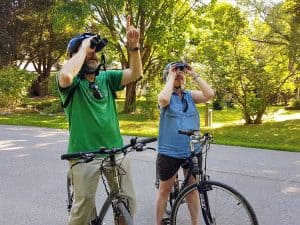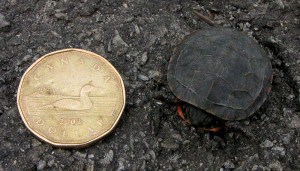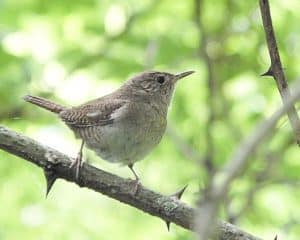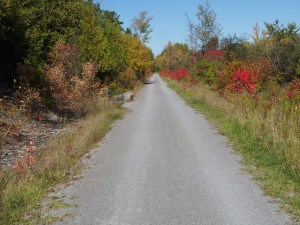Get up close and personal to nature while reducing your carbon footprint
“It is by riding a bicycle that you learn the contours of a country best.” Ernest Hemingway
Riding a bicycle can be a wonderful way to engage with nature and the changing seasons. The feeling of setting off on two wheels is like an adventure, as each outing offers something different. You can enjoy areas that are inaccessible to a car and move along much more quietly. The result is that you see and hear so much more. Even a slow bike ride – the kind I’m referring to – also allows you to wind down, get some exercise and reduce your carbon footprint.
There are even some advantages over walking. You can cover much greater distances and pass quickly through areas of little interest. At the same time, travelling by bicycle is slow and gentle enough to take in all the same sights, sounds and smells as you would on foot. When something of interest grabs your attention, you can simply stop.
Birding
Birding and biking are made for each other. Just this week a friend told me he heard and/or saw 24 species during a 90-minute ride on the Trans Canada Trail from Jackson Park to Ackison Road and back. Highlights included an osprey near Ackison and two northern harriers at Lily Lake. He also saw numerous birds carrying food to feed young. Birding from a bike is far less confined than from a car. There’s no window frames or roof to block your view and no annoying engine, fan or beeping sounds. Unlike getting out of a car, there’s also no need to quietly close the door. When a bird darts across the road or trail, you can quickly and safely stop, put your feet down and lift your binoculars to your eyes. Just remember to pedal slowly enough to observe the habitat you’re passing through, avoid potholes or other obstacles and pay attention to other trail users. Pedalling slowly also eliminates wind noise.
For people who are new to birding – children, for example – travelling by bike is also more fun, since much of birding involves walking, standing and waiting – over and over again.
Equipment
A hybrid is probably the best bicycle choice, although any bike that is suitable for riding on gravel will do. Remember to dress warmly, especially in the spring and fall. Always wear a helmet and consider bringing a pump and maybe even a spare inner tube. Be sure you have a kickstand and lock, too, since you’ll often want to stop, get off the bike and maybe wander down a pathway. Don’t forget water and maybe a snack.
A pair of binoculars is a must – the lighter the better. Remember to keep them around your neck. A binocular harness can be useful, too, because it will stop your binos from swinging about. Don’t forget your smartphone. It can be used as a camera, sound recorder, notebook and for consulting field guide apps like the Sibley eGuide to Birds.
Engaging the senses
Enjoying nature from a bike is a great way to engage all of your senses. A good rule of thumb is to stop briefly each time you enter a new habitat type such as a wetland, woodlot or stream crossing. What new species can you see and hear? Here are some other pointers to keep in mind.
- Vision: Look skyward, to the sides and far ahead. Don’t forget to check the road or trail surface for caterpillars, butterflies, dragonflies, frogs, snakes or maybe even a baby turtle. Check out spots where birds tend to perch such as wires, telephone poles, fence poles and branches of dead trees. In the early morning or evening, scan meadows for deer and maybe even a fox or coyote. Watch the sky, too, for soaring birds like vultures and raptors. Learn to identify the different cloud types and signs of a change in the weather.
- Smell: Notice how the smells change as you pass through different habitat types. Each month, too, has its signature smells. May smells of lilac and balsam poplar; in late June and early July the fragrance of common milkweed and freshly-cut hay often fills the air; late summer can smell of rank vegetation, while the spicy perfume of fallen leaves is a time-honoured scent of fall.
- Touch: Pay attention to how the air temperature changes as you pass from a warm, sunny area to a shaded section of the road or trail. Feel the warmth or coolness of the wind in your face.
- Hearing: Listen for frogs and birds in spring and early summer. The insect chorus begins to take over in mid-July and lasts through early fall. Listen to how each habitat type offers up different voices. Cupping your ears will greatly increase your ability to hear distant sounds.
Seasonal highlights
For each season with the exception of winter, I have provided a very brief list of some common species, nature happenings and sounds to watch and listen for from your bike. How many can you see or hear?
Summer: Red-tailed hawks, turkey vultures, cedar waxwings, grackles, great blue herons, American goldfinches, eastern kingbirds, gray squirrels, chipmunks, groundhogs, painted turtles basking on logs, egg fragments from raided turtle nests, garter snakes, leopard frogs, bumble bees, dragonflies, damselflies, monarchs, sulphur butterflies, Carolina locusts flying up from the ground, fireflies at nightfall, ox-eye daisy, black-eyed Susan, Queen Anne’s lace, tall white clover, common milkweed, Canada goldenrod and poison ivy. Common sounds: Red-eyed vireo, cedar waxwing, American goldfinch, song sparrow, house wren, green frog, dog-day Cicada, crickets
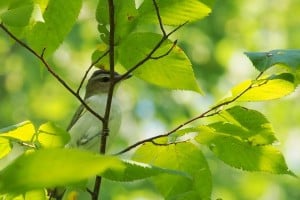
The song of the Red-eyed Vireo is one of the most common sounds of summer on bike trails. (Drew Monkman)
Fall: Blue jay, large flocks of blackbirds, migrating turkey vultures, Canada geese, ring-billed gulls, deer in fields, beavers active in wetlands, squirrel nests in trees, baby snapping turtles, woolly bear caterpillars crossing roads, red and yellow meadowhawk dragonflies, colour change in leaves from early September (e.g., Virginia Creeper, sumac) to early Nov. (tamaracks, oaks), abundant purple New England aster and various white asters, puffball and shaggy mane mushrooms. Common sounds: Blue jay, American crow, Canada geese, crickets
Spring: American robins, red-winged blackbirds, mallards, tree swallows, song sparrows, yellow warblers, groundhogs, muskrats, baby painted turtles, turtles laying eggs, spawning fish, mourning cloak butterflies, midges, green darner dragonflies, tent caterpillars, bumble bees, pussy willows, coltsfoot, trilliums, trout lily, fiddleheads, blooming trees and shrubs, emergence of leaves. Common sounds: Spring peeper, chorus frog, ruffed grouse, American robin, red-winged blackbird, song sparrow, northern flicker, woodpeckers drumming
A few itineraries
The following roads and trails offer different habitat types and a wide variety of species. The roads are relatively free of traffic. To learn about other quiet routes in the Peterborough area, go to biketoptbo.ca/longer-rides/city-cycling-routes/ Created by Cary Weitzman, this site is a treasure-trove of information. Printed maps are available as well at City Hall and local bike shops.
- Hubble Road (east of Stony Lake off Cty Rd 44) Rare birds.
- Sandy Lake Road (30 minutes north of Havelock on Cty Rd 46) Rare birds and butterflies.
- County Road 24: Start at Cty Rd 18 and follow north to Cty Rd 20, north to 10th Line and east to Cty Rd 25. Return the same way. Great wetland and field habitat.
- Fifth Line west from Bridgenorth Trail parking lot to Pinehill Road. Follow Pinehill to Steinkrauss Drive and continue north through residential streets of Bridgenorth to East Communication Road. Follow to Miller Creek Conservation Area on 7th Line. Return to 5th Line by way of Bridgenorth Trail. Great views and varied habitat.
- Roads in provincial parks such as Petroglyphs, Presqu’ile and Carden Alvar.
- Trans-Canada Trail (gravel) from Jackson Park, through Lily Lake Wetland and on to the trestle bridge past Orange Corners Road. Wetland species, diverse shrubs and flowers
- Trans-Canada Trail (gravel) from Lang to Hastings. High butterfly diversity, deer
- Rotary Greenway Trail (paved and gravel) from Peterborough at Parkhill East, past Meadowvale Park, past Trent University, north to County Road 33 and east to Lakefield Sewage Lagoons. Back track and continue up to Lakefield and west to D’eyncourt Street to Lakefield Marsh. Warblers, sparrows along trail; ducks at lagoons, along river and at Lakefield Marsh
- Little Lake Loop (roads and trail) Little Lake Cemetery north to Millennium Park and across pedestrian bridge to Beavermead Park and Ecology Park. Ducks in spring on Little Lake; songbirds and feeders at Ecology Park
- Parkway Corridor (paved) from Jackson Park to Cumberland Street. Retention pond with ducks. Birds in dense vines at Cumberland end.
Fun activities
- Do a family scavenger hunt by using the species and sounds above to make a checklist.
- Go on a sounds ride – how many different natural sounds can you hear?
- Count an individual species – how many monarch butterflies, turkey vultures or other species can you spot?
- Choose your own “Magic Spot”. Find a quiet, nature-rich location along the road or trail where you can get off the bike, sit quietly for five or 10 minutes and relax. Note seasonal changes.
- If you love birding, do a “Big Day” to see how many bird species you find over the course of a day. Former Peterborough resident, Jody Allair, a staff member at Bird Studies Canada, did his Great Canadian Birdathon by bike this spring and found 132 species. He and his team biked 32 kilometres in the Long Point area on Lake Erie.
I’d like to thank Chris Risley and Marilyn Freeman in the preparation of this article.
